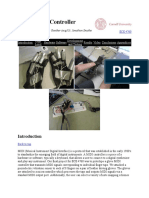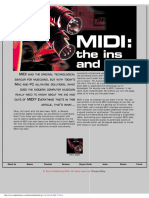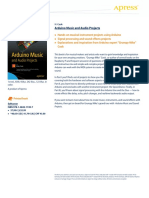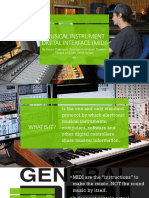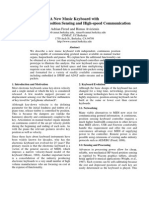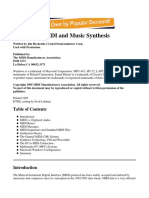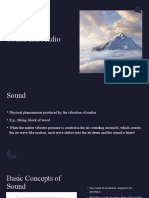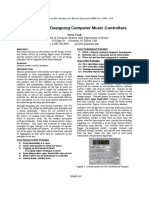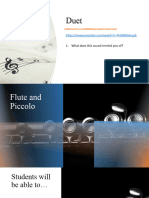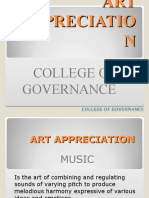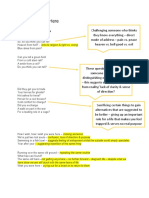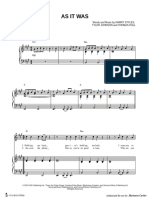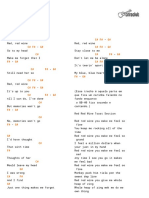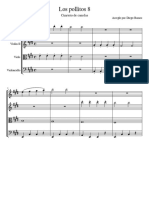Fliperama: An affordable Arduino based MIDI Controller
Rômulo Vieira Flávio Schiavoni
Arts Lab in Interfaces, Computers, and Arts Lab in Interfaces, Computers, and
Everything Else - ALICE Everything Else - ALICE
Federal University of São João del-Rei Federal University of São João del-Rei
São João del-Rei, Brazil São João del-Rei, Brazil
romulo_vieira96@yahoo.com.br fls@ufsj.edu.br
ABSTRACT Despite being almost 40 years old, MIDI is still used
Lack of access to technological devices is a common ex- for the development of new instruments as a feasible way to
ponent of a new form of social exclusion. Coupled with interconnect devices on the shelf. This is because MIDI is
this, there are also the risk of increasing inequality between an open protocol and it is accessible to anyone who wants
developed and underdeveloped countries when concerning to use it.
technology access. Regarding Internet access, the percent- The proof of this is that between 2007 and 2014, sales
age of young Africans who do not have access to technol- of electronic instruments increased by 25%, with a third of
ogy is around 60%, while in Europe the figure is 4%. This that composed by MIDI Controllers, according to Interna-
limitation also expands for musical instruments, whether tional Music Summit [21].
electronic or not. In light of this worldwide problem, this Even with the popularity of new digital instruments,
paper aims to showcase a method for building a MIDI Con- these devices can still be expensive and inaccessible, es-
troller, a prominent instrument for musical production and pecially in underdeveloped countries. Taking into account
live performance, in an economically viable form that can be the socioeconomic situation in Brazil and the difficulties in
accessible to the poorest populations. This equipment can obtaining musical instruments and research materials, this
be also suitable for teaching various subjects such as Mu- paper aims to create a low cost MIDI Controller, called
sic, Computer Science and Engineering. The outcome of Fliperama1 , using techniques from the Do-It-Yourself cul-
this research is not an amazing controller or a brandy new ture and electrical, computing and music concepts.
cool interface but the experience of building a controller Maybe some questions like why to create a new MIDI
concerning all the bad conditions of doing it. controller or how to make it in a multidisciplinary way can
be done and we intend to present and discusse the motiva-
tions and techniques for creating the controller in Section
Author Keywords 2. The creation of this interface can be an outcome by itself
Arduino Pro Micro, Do-It-Yourself, MIDI Controller, Mul- but we think that it is also necessary to show some techni-
tidisciplinary, Social Inclusion cal results obtained from the use of the equipment and its
financial viability. Section 3 will bring it up. Section 4 high-
CCS Concepts lights the multidisciplinary of the controller and how the
socioeconomic disparities interfere in education and artistic
•Applied computing → Sound and music computing; practice. Finally, section 5 presents the lessons learned in
Performing arts; •Human centered computing → User the execution of the project.
studies;
1. INTRODUCTION 2. CREATING THE CONTROLLER
By the mid-1970s, electronic instruments began to appear In this Section we present the process of creation of our in-
more often in pop music, particularly in the three major mu- strument and some questions that probably took our minds
sic consuming markets: United States, Europe and Japan. during the development of our project.
This led the emergence of different manufacturers, with dif-
ferent device models, resulting into a large collection of gad- 2.1 Why to create a new MIDI Controller?
gets and the need of a form of standardization to musical According to the latest report of the United Nations (UN)
equipment and data transfer between them [13, 20]. on Human Development, Brazil occupies the 79th position
It was then, in 1983, that a consortium of synthesizer among the 184 countries that make up the ranking, present-
manufacturers, made up of Roland Corporation, Oberheim ing poor results mainly in income distribution and educa-
Electronics, Yamaha and Korg, created the Music Instru- tion [15].
ment Digital Interface - MIDI, a protocol responsible for These results directly interfere in the music sector, be
standardizing the physical and logical interconnection of it in the musical form of expression or in teaching music
such equipment [2, 3]. to novices or to professionals. The influence of poorness in
music culture starts with an analysis of the difficulty of ob-
taining a quality instrument in the country, be it electronic
or not. In 2018, it is estimated that 90% of music products
sold in Brazil were imported, and in view of the devaluation
Licensed under a Creative Commons Attribution
1
4.0 International License (CC BY 4.0). Copyright Fliperama is how the arcade games like pinball games are
remains with the author(s). commonly called in Brazil. The word is also used to arcade
NIME’20, June 21-25, 2020, Royal Birmingham Conservatoire, Birming- game rooms, places where you can play games using a coins
ham, England. or paying for hour usage.
375
�of the Brazilian currency, the value of instruments increased out the Maker culture and DIY, with roots in activities
significantly [19]. involving electronics and technology at low cost, allow the
It is also worth mentioning the obstacle imposed by general public access to something previously considered re-
the low income distribution. In 2020, the minimum wage in stricted [17, 10].
the country is less than US$ 180.00 (data from April 30th, Another striking feature of DIY methodology is the
20202 ). Thus, most citizens turn their incomes to meet basic multidisciplinary ability to cover many different fields of
needs, causing the consumption of music and other forms study. In the Fliperama project, there is Electrical engineer-
of artistic expression to be set aside by a portion of society ing, present in the composition and way of communication
[8]. These situation create a unbalanced scale summing high of the pieces that make up the project, Computer Science,
cost to import technological goodies, a bad exchange values mainly Computer Music, represented by the way the MIDI
to our currency and a very low income. Controller works together with software and other computer
Therefore, the creation of a new model of MIDI Con- systems, and of course, Music.
troller, using open-source technologies and low-cost prod- The advantages of a multidisciplinary system range
ucts, can make musical production and creation more ac- from providing students with higher quality learning, to
cessible. developing problem-solving skills and critical thinking and
Beyond the currency value and low income, taxes to a taste for learning. It is also very useful for educators,
import products and the profit of companies make the ac- helping them to expand their borders and making teaching
quisition of a digital interface even harder and some times richer and more enjoyable [4, 5].
unfeasible. Table 1 shows a comparison between the prices
of MIDI Controllers sold in the domestic market comparing 2.3 What kind of MIDI Controller are we in-
Brazil and US. The prices were based on international Ama- tend to create?
zon (amazon.com) and Brazilian Amazon (amazon.com.br). Possibilities of creating this equipment are numerous. Be-
cause there is no formula to follow, an instrument can and
do represent cultural and aesthetic characteristics of the
creators, as advocated by Lepri and McPherson [7]. Other
Table 1: Price comparison of MIDI Controllers.
than that, a Controller can expand to assist the pedagog-
Product BRL Price (R$) US price(U$)
ical part of music and engineering [9], as well as being an
Axiom AIR Mini 32 R$ 1030,00 U$ 162.69 instrument of leisure and fun, stimulating the inventiveness
Nektar Impact LX25+ R$ 979,90 U$ 149.95 and imaginative use of a digital system by the user [1].
Akai APC Key R$ 815,00 U$ 129.00 From this project, it is expected that it will be easy
Samson Conspiracy R$ 843,00 U$ 211.98 to understand and use for inexperienced or lay-technology
Launchkey Mini MK2 R$1.199,90 U$ 109.64 users. Thus, it was developed to be plug-and-play and easy
for computer connection. Users with little knowledge of
music are also targeted, so switching from common keys to
2.2 How do DIY and multidisciplinarity con- pianos to joystick buttons makes it easy to execute simple
tributed to the project? commands.
As the MIDI protocol is present in all Digital Audio
The DIY, an abbreviation for do-it-yourself, is the activity
Wokstation (DAW), the model shown here is capable of op-
of making or repairing things yourself, especially in your
erating on proprietary software such as Ableton Live, Logic
home. This concept is intrinsically linked to art and very
Pro and FL Studio, as well as open source software such as
important in its diffusion. Records, concerts, promotional
LMMS and Ardour. The control to be performed on them
material, and now, instruments, are gaining more and more
is simple, involving binary execution of the notes, that is,
space in this environment, driven by technological resources.
once a button is pressed, the sound corresponding to that
There is a relationship here between DIY and the concept
button is transmitted, otherwise no sound will be made.
of open source, as both prioritize autonomy, low cost of
Instrument and plugin envelopes should also be subject to
production and free circulation of the means used to create
control.
something [18].
This methodology has also gained ground in schools, 2.4 Project parts
helping to make learning methods more attractive and en-
This project has a fez electrical components. An Arduino
couraging students to develop their own projects based on
Pro Micro played a central role in the operation of the equip-
the theoretical content presented in class. Among the ad-
ment. In addition to performing its basic microcontroller
vantages observed in the use o DIY as a learning methodol-
functions, it also made direct conversions between USB and
ogy are the digital inclusion, a presentation to the student of
MIDI communication standards, thus eliminating the need
all stages of the project and facilitating the teacher’s work
for third party software for this. Being an open-source tool
[17].
also contributed to lower the final price of the product.
While in rich countries this methodology is linked with
CD4067 Multiplexer also played a crucial function for
the idea of learning, researching and self empowerment, in
the project. Since Arduino Pro Micro did not have all the
poor country the DIY is sometimes the possibility to reach
outputs required for the project, it was up to it to extend
and use technology. The difficulties of accessing technology
in emerging countries are due to several reasons, such as: the number of outputs, allowing for greater connection of
lack of infrastructure, authoritarian governments that limit control interfaces.
access to information and armed conflicts occurring in the As for the control interfaces, two distinct components
country [11]. were used. First of these was rotary potentiometer, which is
In the case of Brazil, this access is restricted by the responsible for adjusting analog functions within the DAW,
high price of products and also by the lack of access to the such as volume control and envelope editing. The second
means that produce them. It is in this context that stands one was the Sanwa joystick buttons. With binary func-
tion, they were responsible for replacing the piano keys or
2
Conversion made on April 30, 2020, when US$ 1 = BRL percussion pads, common in this type of equipment. This
5.44 replacement helped to reduce the price of the product and
376
�also attributed a playful character to the instrument. In
short, 7 potentiometers were used, each with 10 KΩ and 16
Sanwa buttons.
All of these devices were soldered into a protoboard.
The choice of welding, rather than snap connections, was
chosen to ensure greater accuracy of the electro-electronic
connections and also to increase their protection when trans-
porting the equipment.
Figure 1 shows a schematic drawing of all electronic
connections in the project.
Figure 3: Fliperama MIDI Controller after mount-
ing completed.
equipment. The DAW chosen here was Ableton Live 10.
Figure 1: Illustrative image of all MIDI Controller Despite all the possibilities of mapping, we started with
electrical connections. the simple one-to-one mapping each button to a MIDI note
message. Since the buttons are just a common push button,
All programming and code insertion in Arduino Pro there is no dynamic control and the notes are played always
Micro was done in its own IDE. Although it is most current with the same MIDI velocity.
version is 1.8.10, the one used for the project was 1.6.8. This Starting with drums, three kits were selected, Kit-Core
is due to the fact that it has two important libraries for the 606, Kit-Core Stark and Selector Kit Clean. Each of drum
project that were not present in the newer version of the IDE set contained 16 parts of a real drum. So, for all 3 options,
when we looked for it. First of these is the MIDI library, MIDI Controller was able to act individually on each of
which is responsible for directly converting this protocol to these parts. In addition, potentiometers were targeted for
what is interpreted by an USB cable. The second one is volume and note envelope control.
the Thread library, which allows multiple commands to be Piano tests were also performed on two simulators:
executed simultaneously. Thus, multiple interfaces execute Grand Piano and Tinefull Ambient. Once the simulator
command at the same time, not having to wait for a prede- was selected, MIDI Controller was already able to play the
cessor command to be terminated before a new statement notes, following a left-to-right order. It was up to the mu-
begins. sician only to define which characteristics would be the re-
Once the connections were finished, they were encap- sponsibility of the potentiometers.
sulated in an acrylic case. A representation is shown in
Figure 2 [16]. 3.1 Results from technical performance
The best performance was for the drums. Beyond the fact to
the size of the Controller that perfectly matched the tested
kits, the latency was 0.3 ms and none of the buttons showed
structural damage while in use. This means that besides
being useful for studio production, this equipment can serve
as a drumfinger in concerts.
For piano samples, the MIDI controller performance
was a bit lower compared to the previous test with drums
samples. Running pianos’ tracks separately, Grand Piano
simulator required 10% of the computer’s memory capacity.
It is also worth that the 64-key condition of piano was not
Figure 2: Schematic drawing of the acrylic case. satisfied. Nevertheless, sound quality and functionality of
the product were not affected.
Weldable protoboard was left outside the acrylic case For Tinefull Ambient, the memory consumption was
to facilitate the soldering process, possible replacement of lower, around 7%. Again, the main condition was not sat-
some component and also to facilitate the connection of the isfied, but nothing that would compromise the execution of
MIDI Controller to the computer or other interfaces that this simulator.
accepts this type of connection. To complete the enclosure,
drops of silicone were glued to the bottom of the shell to 3.2 Price Comparison
prevent the Controller from moving when resting on any Once functionality of the product is gauged, it is time to
flat surface. Final model it is shown in Figure 3. check if its price is really below market price, including those
with Arduino technology, and to see if this price fits the
3. RESULTS reality of beginning musicians and students in Brazil. Table
Once assembled, the MIDI Controller was connected to a 2 shows used equipment, obtained in the local market, and
DAW to check the functionality and performance of the their respective prices, in dollars and in Brazilian currency,
377
�Real 3 . The experience of creating an electronic musical in-
strument is more than valid because it explores creativity
and multiple fields of study unveiling the technology behind
Table 2: Equipment price list. the scenes and exposing the DIY culture as a possibility to
Product BRL price(R$) US price ($) change the actual situation. From the electronic equipment
01 Arduino Pro Micro R$ 27,50 U$ 5.05 inherent in engineering, as well as the integration of the sys-
01 Protoboard R$ 12,00 U$ 2.20 tem with software and how it applies in concerts and aids
01 Multiplexer CD406 R$ 14,31 U$ 2.63 in a producer’s workflow, requires an intersection between
16 Sanwa buttons R$ 40,00 U$ 7.32 these three areas.
07 Rotary potentiometers R$ 9,66 U$ 1.77 Regarding strengths, this MIDI Controller still had
AWG wires R$ 16,90 U$ 3.10 better cost-effectiveness benefit compared to outstanding
01 Case R$ 98,00 U$ 18.00 equipment in the market, including those using the same
Total R$ 218,37 U$ 40.07 technology. In addition to affordable and made up of easily
accessible parts, the component has a large number of but-
tons that help musicians from the most diverse genres, both
From the numbers presented, it can be seen that prod- in studio productions as well as live performances. About
uct developed here has a cost equivalent to 21.5% of the the structure of the equipment, it is important to highlight
minimum wage in Brazil. It also represents 16% of the na- that despite using low price components and have an al-
tional average income. ternative technology, the tests have proven that it has the
same functionality and accuracy as the others, covering all
4. DISCUSSIONS the requirements of a musician, producer or student.
Combining the advantages of teaching with DIY and
The creation of the MIDI Controller is a multidisciplinary the need to allow technology to be accessible to the poorer
task in view of the technologies used for it. The choice of classes, creation of electronic instruments, as well as the
electronic components, their distribution in a circuit and conscious and sustainable use of these resources[6], should
welding process, refer to basic principles of Electrical en- be explored to assist in the teaching and creation of music
gineering. Computer Science is present in the use of pro- and other art forms.
gramming languages that will determine the behavior of We need more experiments with other mapping tech-
the device, as well as in its integration with the computer niques and some future works include to test different ap-
and in the transformation from MIDI protocol to USB and proaches, like one-to-many or even many-to-many mapping
vice versa. Music fundamentals are necessary for the use possibilities. Probably, we will use some classical arcade
of DAW, control of its properties and good usability of the combinations to perform these mappings [12].
equipment. The MIDI protocol is the maximum represen-
tation of this plurality of fields of study, interacting with all
of them. 6. ACKNOWLEDGMENTS
This characteristic makes the Controller construction We believe that it is not fair to use the economic situation
also useful for teaching, especially for children and adoles- of our country to justify a paper concerning social issues of
cents or those not started in any of these fields. The use of DIY methods and make culture. Unfortunately, nowadays,
the Arduino platform also contributes to this, as it allows that is our situation, a country that is utterly rich and could
students to create the most diverse projects. be an amazing place to live that is passing through social
The inheritance of historical events directly interfere problems because of wrong political choices and decisions.
with socioeconomic conditions and public policies practiced A few years ago, when our country used to invest in social
in underdeveloped countries. This reflects directly on re- improvement, science and education, it was not possible to
search, education and artistic practice. The lack of invest- use Brazil to illustrate this paper as an example of places
ment in research implies the need to import materials, which where the DIY culture is more related to poverty than with
makes the final product more expensive, making it less and freedom. That’s why we would like to thank president Lula
less accessible. In education, the lack of resources does not da Silva and Dilma for what they did in our near past. We
allow the completion of the academic curriculum, leaving hope that this paper will not make sense in a near future.
gaps in learning. For the artistic environment, the prob- Authors would like to thanks to all ALICE members
lems are reflected in the increased value of their work tools, that made this research and development possible[14]. The
such as musical instruments, for example. authors would like also to thank the support of the funding
Thus, the creation of new interfaces for musical expres- agencies CNPq, grant no. 151975/2019-1, FAPEMIG and
sions is not only an alternative for students, scientists and CAPES.
artists from these countries, it is also a need they have to
produce their material. The MIDI Controller shown here 7. REFERENCES
is capable of meeting all these needs, since it uses low-cost [1] J. Barbosa, M. M. Wanderley, and S. Huot. Exploring
materials, assists teachers and students in learning various playfulness in nime design: The case of live looping
disciplines and is still useful for professional musicians or tools. In Proceedings of the International Conference
beginners. on New Interfaces for Musical Expression, pages
87–92, Copenhagen, Denmark, 2017. Aalborg
5. CONCLUSIONS University Copenhagen.
[2] R. P. P. Bodo. Midi como protocolo de comunicação e
Development of this paper has allowed a new approach to
partitura digital, November 2014.
creating a MIDI Controller by applying to it multiple con-
cepts, from Engineering to Computer Music and Music it- [3] B. Edstrom. Arduino for Musicians: A Complete
self. Guide to Arduino and Teensy Microcontrollers. OUP
USA, New York, 2016.
3
Conversion made on April 30, 2020, when US$ 1 = BRL [4] I. Fazenda. Interdisciplinaridade - Um projeto em
5.44 parceria. Edições Loyola, São Paulo, Brazil, 1991.
378
� [5] I. Fazenda. Didática e Interdisciplinaridade. Papirus
Editora, São Paulo, Brazil, 1998.
[6] I. S. Junior and F. Schiavoni. Sustainable interfaces
for music expression. In F. Schiavoni, T. Tavares,
R. Constante, and R. Rossi, editors, Proceedings of
the 17th Brazilian Symposium on Computer Music,
pages 63–68, São João del-Rei - MG - Brazil, Sept.
2019. Sociedade Brasileira de Computação.
[7] G. Lepri and A. P. McPherson. Fictional instruments,
real values: discovering musical backgrounds with
non-functional prototypes. In M. Queiroz and A. X.
Sedó, editors, Proceedings of the International
Conference on New Interfaces for Musical Expression,
pages 122–127, Porto Alegre, Brazil, June 2019.
UFRGS.
[8] R. Marchesan. Novo salário mı́nimo de 1.039 reais
definido pelo governo perde para inflação, 2020.
[9] A. Marquez-Borbon and J. P. Martinez-Avila. The
problem of dmi adoption and longevity: Envisioning a
nime performance pedagogy. In T. M. Luke Dahl,
Douglas Bowman, editor, Proceedings of the
International Conference on New Interfaces for
Musical Expression, pages 190–195, Blacksburg,
Virginia, USA, June 2018. Virginia Tech.
[10] A. Paula. O conceito diy e a realidade opensource,
2016.
[11] P. Peiró. Acesso à tecnologia: o novo indicador de
desigualdade, 2017.
[12] G. L. Rocha, J. T. Araújo, and F. L. Schiavoni. Ha
dou ken music: Different mappings to play music with
joysticks. In M. Queiroz and A. X. Sedó, editors,
Proceedings of the International Conference on New
Interfaces for Musical Expression, pages 77–78, Porto
Alegre, Brazil, June 2019. UFRGS.
[13] D. Saxena and N. Abhilash Kumar. Midi (musical
instrument and digtal interface). In International
Conference on Advanced Computing (ICAC-2016),
pages 1–4, 2016.
[14] F. Schiavoni, A. Gomes, J. a. T. Araújo, F. Resende,
I. S. Junior, G. L. Rocha, A. Paulo, I. Andrade,
M. C. F. Canito, and R. A. V. Costa. Alice: Arts lab
in interfaces, computers, and everything else -
research report (2019). In F. Schiavoni, T. Tavares,
R. Constante, and R. Rossi, editors, Proceedings of
the 17th Brazilian Symposium on Computer Music,
pages 157–164, São João del-Rei - MG - Brazil, Sept.
2019. Sociedade Brasileira de Computação.
[15] M. Schreiber. Após anos de crise, brasil recua no
ranking de desenvolvimento humano da onu, 2019.
[16] G. Silveira. Músico Nerd construa este controlador
midi usando um arduino: Fliper dj, 2016.
[17] L. Souza. Cultura do ”faça você mesmo” ganha espaço
nas salas de aula, 2018.
[18] A. Spencer. DIY: The Rise of Lo-Fi Culture. Marion
Boyars Publishers Ltd, London, UK, 2008.
[19] G. Tamamar. Setor de instrumentos musicais sofre
com dólar alto, 2016.
[20] J. D. Wale. A brief introduction to midi. http:
//www.j-omega.co.uk/Downloads/MIDI_intro.pdf,
May 2013.
[21] K. Watson. Ims business report 2017: An annual
study of the electronic music industry, 2017.
379








